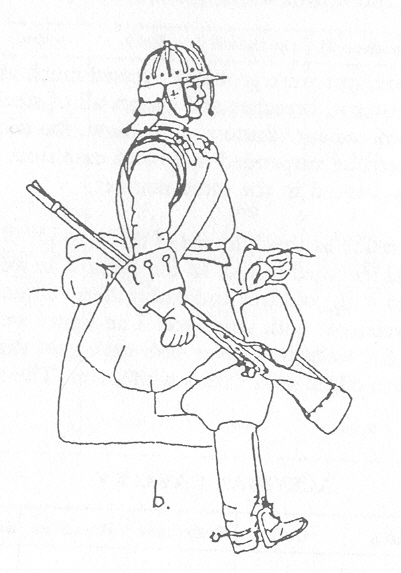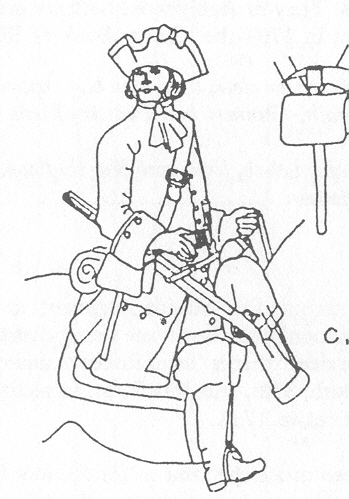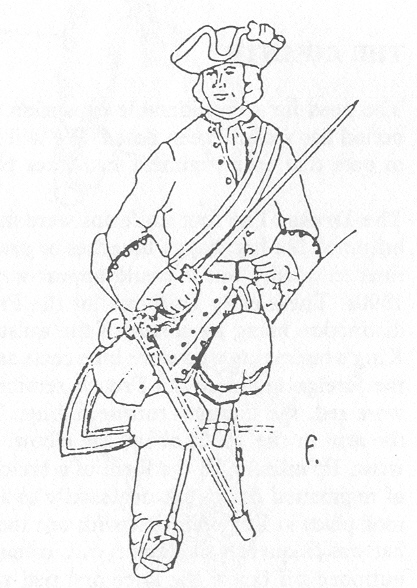| Author |
Message |
|
Lafayette C Curtis
|
 Posted: Tue 17 Apr, 2007 8:46 am Post subject: Method of cavalry firearms attachment Posted: Tue 17 Apr, 2007 8:46 am Post subject: Method of cavalry firearms attachment |
 |
|
I've been wondering about the way early and mid-18th century European cavalry would carry their long firearms (muskets or musketoons) with the muzzle pointing up, like in the paintings on this page:
http://www.britishbattles.com/battle_of_dettingen.htm
Can anybody refer me to some more detailed information about how these firearms were attached/secured, either to the trooper or to the saddle? I'd be especially grateful for a reference to a relevant cavalry manual (whether online or print).
|
|
  |
 |
Daniel Staberg

|
 Posted: Tue 17 Apr, 2007 2:18 pm Post subject: Posted: Tue 17 Apr, 2007 2:18 pm Post subject: |
 |
|
Here a few reconstructions of Horse and Dragoons during the War of Spanish Succesion.
IIRC correctly the method was mainly used on the march, in combat the carbine would be unslung and carried with the muzzle downwards, ready for use. This was at least true for the Saxon and Austrian troops but at least in the 'East' they had developed tactics which focused on extensive use of carbine and pistol to break up Ottoman charges.
How the carbine was carried by cavalry which used the sword as the primary weapon I'm not sure, it would depend on wether the suspension was an obstacle in a sword fight or not.
Not all cavalry used this method of suspension, the French used a diffrent method as can be seen below.
Cheers
Daniel
 Attachment: 85.34 KB Attachment: 85.34 KB

Austrian Cuirassier
 Attachment: 78.87 KB Attachment: 78.87 KB

English Dragoon
 Attachment: 106.36 KB Attachment: 106.36 KB

French Chevauxleger
|
|
  |
 |
|
Lafayette C Curtis
|
 Posted: Thu 19 Apr, 2007 4:31 am Post subject: Posted: Thu 19 Apr, 2007 4:31 am Post subject: |
 |
|
Very interesting. Am I right in thinking that those pictures show the weapons placed into some sort of sling not permanently attached to it, which in turn is looped over one of the pistol holsters (and possibly the saddle's pommel)?
BTW, you said
| Quote: | | in combat the carbine would be unslung and carried with the muzzle downwards |
At first I thought this is the familiar method uf using a cross-belt to carry a carbine hanging muzzle-downwards by the right hip, but it can also be read as the carbine being entirely unclung and carried in the hand. Would you mind clarifying this point?
|
|
  |
 |
Daniel Staberg

|
 Posted: Fri 27 Apr, 2007 4:02 am Post subject: Posted: Fri 27 Apr, 2007 4:02 am Post subject: |
 |
|
| Lafayette C Curtis wrote: |
Very interesting. Am I right in thinking that those pictures show the weapons placed into some sort of sling not permanently attached to it, which in turn is looped over one of the pistol holsters (and possibly the saddle's pommel)?
|
| Lafayette C Curtis wrote: |
There seems to be two ways, the one used by carbines armed cavalry who had the eapon attached to a bandolier/cross belt. They would insert the butt of the carbine in the leather 'bucket' suspended from pistol holster in order to keep the carbine steady on the march.
Dragoons didn't use cross belts and instead helt the musket in place wit the 'buvket' mentioned above as well as a strap that was attached to the pommle or apparently held simply in the hand(?)
| Daniel Staberg wrote: | | in combat the carbine would be unslung and carried with the muzzle downwards |
At first I thought this is the familiar method uf using a cross-belt to carry a carbine hanging muzzle-downwards by the right hip, but it can also be read as the carbine being entirely unclung and carried in the hand. Would you mind clarifying this point?
|
I meant the familiar method, I've never read about cavalry unhooking their carbines from the bandolier while mounted.
|
|
  |
 |
|
Lafayette C Curtis
|
 Posted: Fri 27 Apr, 2007 4:32 am Post subject: Posted: Fri 27 Apr, 2007 4:32 am Post subject: |
 |
|
|
Thank you very much! That's extremely helpful, even if it indicates that we're not all that sure about how it was really done in the Dragoons' case.
|
|
  |
 |
M. Eversberg II

|
 Posted: Fri 27 Apr, 2007 12:00 pm Post subject: Posted: Fri 27 Apr, 2007 12:00 pm Post subject: |
 |
|
I would have thought it would have been slung across the back; seems natural to me.
M.
This space for rent or lease.
|
|
      |
 |
|
Lafayette C Curtis
|
 Posted: Sat 28 Apr, 2007 1:16 am Post subject: Posted: Sat 28 Apr, 2007 1:16 am Post subject: |
 |
|
| M. Eversberg II wrote: | | I would have thought it would have been slung across the back; seems natural to me. |
it might seem natural to people who don't regularly carry rifles or carbines on horseback, but once you've tried it you'll find that it doesn't allow you to put the weapon quickly into firing position. Cavalrymen who sling their long firearms close to their bodies usually place them on the chest, not on the back--though I think it's still not quite as efficient as slinging it muzzle-down by the hip. With the weapon just next to your hip you could just seize it by the lock, present, and fire in one smooth movement.
|
|
  |
 |
Gordon Frye

|
 Posted: Mon 30 Apr, 2007 3:53 pm Post subject: Posted: Mon 30 Apr, 2007 3:53 pm Post subject: |
 |
|
I'm not exactly sure of when the carbine sling and bar came into broad use, but it's last-half of the16th Century at earliest. From ca. 1600 through 1650, carrying the carbine "dropt" from the sling (which had a swivelling snap-hook fitted to it and was snapped on to the carbine sling-bar ring which was fitted to the left side of the carbine), was the common method of carry for Harquebusiers, but illustrations from Walhausen show a sling-strap fitted to short muskets for issue to Dragoons, and further illustrations of Dragoons carrying their muskets strapped across their backs.
Late-17th and 18th Century Dragoons definitely used the methods shown by Daniel above to carry their long-arms while on the march. For some, they kept the carbine sling swivel-snap fixed to the sliding ring on the ring bar of the carbine or musketoon, but others, such as shown in the second illustration didn't require it, but relied on a strap fitted to the saddle and wrapping around the wrist of the firearm to hold either the muzzle or butt of the arm in a "boot" or "bucket" which was also slung from the saddle.
The system certainly came in much earlier, but my personal experience with these is when portraying US Dragoons from the late-18th through the mid-19th Century, who used the method of carrying the carbine "dropped" or just hanging from the carbine sling when ready for battle, but when on the march the muzzle fitted into the carbine boot. It was done as in the lower illustration it shows it with a strap going from the near side of the saddle and wrapping around the wrist of the carbine. This is actually a VERY comfortable way to carry the carbine, as it rides on your right thigh, rather than hanging from your shoulder. The added (and very handy) advantage is that while the carbine is in its boot (which is attached to the saddle), it's not attached to YOU as well. Bloody awkward (to say the least) to be forcibly dismounted and still have this strap going across your chest which is attached to something fixed to the saddle. With the muzzle or butt in the bucket/boot strapped to the saddle, you don't get into these awkward situations. 
During the late-19th and 20th Centuries there were plenty of cases where the Dragoons/Mounted Infantry were forced for lack of a better solution to simply sling their rifles across their backs like an Infantryman, but it's certainly not the optimum method. I've done it and didn't like it a bit, for two reasons. First, there's the ever-present possibility of being thrown from your horse, and if you land on your back, the very least injury would be a badly bruised back, and quite possibly broken vertibrae. If you're lucky then you'd simply hit the deck with the rifle having it's sling broken, but a broken stock is also in the cards for such a dismounting choice. Another problem (experienced by a compadre of mine while I was riding with him) was that if the sling isn't tight against your back, the pounding of the gunstock against your back can cause some serious problems for your vertibrae yet again. So although it was done plenty of times, it's far from optimum. Almost all militaries tried in some way or another to figure out a method of carrying the musket/carbine/rifle on the horse, while allowing instant access by the trooper. Hard to do sometimes, unfortunately.
Oh, as a note: the main reason that the sling-bar and ring on the left side of the carbine had to be rather long was so that the carbine could be turned and "dropt" to facilitate loading from the muzzle. The short ring-bars one often sees on carbines from the 19th Century only work on breechloaders or very short muzzle-loaders, for otherwise you have a very awkward on-shot-per-engagement weapon, or else you dismount to reload. Unhandy, that.
Interestingly enough, one of the methods used by American Frontiersmen during the time of the American Revolution was to make up a boot or bucket that was laced to the outside of their right stirrup, into which the butt of their Long Rifle was placed. The muzzle end was then inserted into the straps of their shooting pouch (with attached powder horn, etc.) slung from their right side as well. The method was by all accounts very comfortable and secure, the only difficulty was in that if you DID get bucked off, the rifle was toast (unless you grabbed in in mid-flight). The other method was of course to carry it across the pommel of the saddle, but although it's great when you're in a gaggle, doesn't work very well when in a formation of cavalry.
Cheers!
Gordon
"After God, we owe our victory to our Horses"
Gonsalo Jimenez de Quesada
http://www.renaissancesoldier.com/
http://historypundit.blogspot.com/
|
|
    |
 |
|
GG Osborne
|
 Posted: Mon 30 Apr, 2007 5:39 pm Post subject: Posted: Mon 30 Apr, 2007 5:39 pm Post subject: |
 |
|
Also note that early light English dragoons dis not carry carbines at all (in the common usage of a short barreled musket) but a standard carbine bore (.69) with perhaps a 42" barrel and a lighter profile. The plates from the Duke of Cumberland's Clothing Book show the carbine/muskets carried with the butt on the saddle and the muzzel sticking up. In some you can see the cloth tompion used to "stopper" the muzzel against rain.
Finally, at least the Spanish / Catalonian Escopeta had a large brass belt hook and was carried hung on the belt.
"Those who live by the sword...will usually die with a huge, unpaid credit card balance!"
|
|
  |
 |
|
Lafayette C Curtis
|
 Posted: Tue 01 May, 2007 9:19 pm Post subject: Posted: Tue 01 May, 2007 9:19 pm Post subject: |
 |
|
Very interesting. The first time I learned about this I didn't have the time and resources to try out all the possible combination, so all I knew (and did) was the practice of hanging the firearm by the hip/thigh. I certainly wasn't expecting this flood of information when I decided to go over it once again! 
|
|
  |
 |
Elling Polden

|
 Posted: Wed 02 May, 2007 1:39 am Post subject: Posted: Wed 02 May, 2007 1:39 am Post subject: |
 |
|
Gordon;
Would this sling and bar arrangement resemle a modern day assault sling?
Is there pictures of it available?
"this [fight] looks curious, almost like a game. See, they are looking around them before they fall, to find a dry spot to fall on, or they are falling on their shields. Can you see blood on their cloths and weapons? No. This must be trickery."
-Reidar Sendeman, from King Sverre's Saga, 1201
|
|
    |
 |
Gordon Frye

|
|
    |
 |
|
Lafayette C Curtis
|
 Posted: Wed 02 May, 2007 10:39 am Post subject: Posted: Wed 02 May, 2007 10:39 am Post subject: |
 |
|
|
I was going to answer, but as usual Gordon got there first. As for the slings, they don't really look like modern assault rifle slings since you can plainly see from gordon's picture that it's only attached to the weapon at one point--the ring. Imagine it as a crossbelt with the weapon attached at its lowest point. Or maybe a particularly long baldric with a firearm instead of a sword or dagger. However, the troops that started as mounted infantry--such as dragoons and horse grenadiers--sometimes used infantry-type slings which would have been quite similar to a modern rifle sling in its basic principles.
|
|
  |
 |
|
Jonathan Hopkins
|
 Posted: Wed 02 May, 2007 12:41 pm Post subject: Posted: Wed 02 May, 2007 12:41 pm Post subject: |
 |
|
Here is a decent illustration from the Osprey title British Cavalryman 1792-1815 by Haythornthwaite:
 Attachment: 100.83 KB Attachment: 100.83 KB
[ Download ]
|
|
  |
 |
|
|

